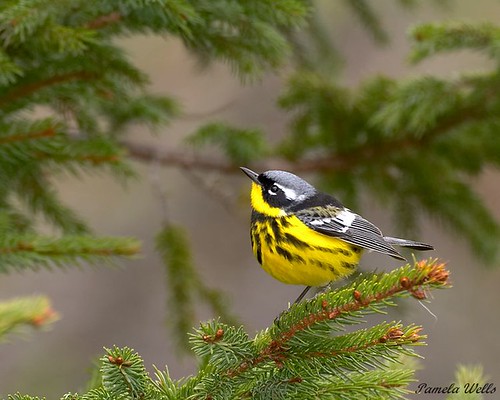
Male magnolia warbler, Dendroica magnolia.
This image appears here with the kind permission of the photographer, Pamela Wells.
Click image for larger view in its own window.
Birds in Science
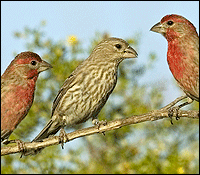 Spring is the season for flashy mates, at least for house finches, Carpodacus mexicanus (pictured, right). It is only later in the year that the females choose based on genetic diversity, according to new research from two scientists at the University of Arizona. Their 10-year study of a colony of 12,000 finches in Montana has revealed the seasonal dynamics of finch attraction and thereby resolved an evolutionary conundrum. Previous research had shown that female house finches choose the most resplendent mates; the males with the reddest breast. On the other hand, if the population is relatively stable, they would become inbred if all females mated with the flashiest guy. Instead, female finches should seek out males with the most genetic difference from themselves. To investigate this conundrum, ecologist Alexander Badyaev has spent the last 10 years photographing, taking DNA samples and measuring the relative rosiness of any given male finch's breast from the Montana population. By 2004, he knew the intimate details of the entire population, including who was mating with whom, who was cheating on whom, and whose genes were passed on to the next generation. "We have 10 sequential generations of wild birds completely genotyped," he said. "It's never been done before." By analyzing the data, the researchers found that early in the mating season, females chose the male finch with the reddest breast. But as the season wore on -- and new females entered the population -- they typically chose males with strong genetic differences from themselves. And those tempted to stray typically chose a mate more genetically different than their regular partner, according to the research presented in Proceedings of the Royal Society B.
Spring is the season for flashy mates, at least for house finches, Carpodacus mexicanus (pictured, right). It is only later in the year that the females choose based on genetic diversity, according to new research from two scientists at the University of Arizona. Their 10-year study of a colony of 12,000 finches in Montana has revealed the seasonal dynamics of finch attraction and thereby resolved an evolutionary conundrum. Previous research had shown that female house finches choose the most resplendent mates; the males with the reddest breast. On the other hand, if the population is relatively stable, they would become inbred if all females mated with the flashiest guy. Instead, female finches should seek out males with the most genetic difference from themselves. To investigate this conundrum, ecologist Alexander Badyaev has spent the last 10 years photographing, taking DNA samples and measuring the relative rosiness of any given male finch's breast from the Montana population. By 2004, he knew the intimate details of the entire population, including who was mating with whom, who was cheating on whom, and whose genes were passed on to the next generation. "We have 10 sequential generations of wild birds completely genotyped," he said. "It's never been done before." By analyzing the data, the researchers found that early in the mating season, females chose the male finch with the reddest breast. But as the season wore on -- and new females entered the population -- they typically chose males with strong genetic differences from themselves. And those tempted to stray typically chose a mate more genetically different than their regular partner, according to the research presented in Proceedings of the Royal Society B.
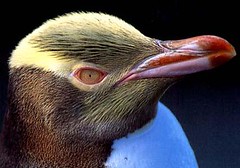 The oldest penguin fossils yet found suggest that at least some ancestors of modern birds existed at the same time as dinosaurs and that they survived the mass extinction that killed the dinosaurs. The 58- to 62-million-year-old bones unearthed in New Zealand belong to four specimens of a previously unknown genus of ancient penguin called Waimanu. Ewan Fordyce, a paleontologist at the University of Otago in Dunedin, helped analyze the fossils. "When [we] saw that penguin lineages were established by 60 or 62 million years ago, it became clear that other bird lineages, which were more remote from penguins, must have had earlier origins," he said. This study appeared in last month's online issue of the journal Molecular Biology and Evolution. (Yellow-eyed penguin, Megadyptes antipodes, pictured). GrrlScientist note: Amazing! I wonder what special qualities birds possess that allowed them to survive this mass extinction?
The oldest penguin fossils yet found suggest that at least some ancestors of modern birds existed at the same time as dinosaurs and that they survived the mass extinction that killed the dinosaurs. The 58- to 62-million-year-old bones unearthed in New Zealand belong to four specimens of a previously unknown genus of ancient penguin called Waimanu. Ewan Fordyce, a paleontologist at the University of Otago in Dunedin, helped analyze the fossils. "When [we] saw that penguin lineages were established by 60 or 62 million years ago, it became clear that other bird lineages, which were more remote from penguins, must have had earlier origins," he said. This study appeared in last month's online issue of the journal Molecular Biology and Evolution. (Yellow-eyed penguin, Megadyptes antipodes, pictured). GrrlScientist note: Amazing! I wonder what special qualities birds possess that allowed them to survive this mass extinction?
People Hurting Birds
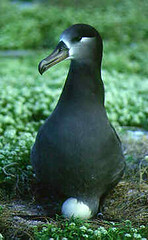 Black-footed albatross, Phoebastria nigripes (pictured), which forage in California waters, have several times as many contaminants in their bodies as Laysan albatross, Phoebastria immutabilis, which forage further north, although contaminant levels have increased in both species during the last 10 years. Because albatross are at the top of the marine food chain, their bodies accumulate toxic contaminants, such as mercury, PCBs (polychlorinated biphenyls) and DDT (dichloro-diphenyl-trichloroethane). Albatross blood samples taken in 2000 and 2001 were found to have 130- to 360-percent higher contaminant concentrations than those taken in 1991 and 1992, according to the press release, with black-footed albatross experiencing the greatest increase. "A lot of people think this issue has been taken care of, but it is still very much a problem," said Myra Finkelstein, leader of the study and a postdoctoral researcher at the University of California, Santa Cruz. This research was published in the April issue of the peer-reviewed journal, Ecological Applications.
Black-footed albatross, Phoebastria nigripes (pictured), which forage in California waters, have several times as many contaminants in their bodies as Laysan albatross, Phoebastria immutabilis, which forage further north, although contaminant levels have increased in both species during the last 10 years. Because albatross are at the top of the marine food chain, their bodies accumulate toxic contaminants, such as mercury, PCBs (polychlorinated biphenyls) and DDT (dichloro-diphenyl-trichloroethane). Albatross blood samples taken in 2000 and 2001 were found to have 130- to 360-percent higher contaminant concentrations than those taken in 1991 and 1992, according to the press release, with black-footed albatross experiencing the greatest increase. "A lot of people think this issue has been taken care of, but it is still very much a problem," said Myra Finkelstein, leader of the study and a postdoctoral researcher at the University of California, Santa Cruz. This research was published in the April issue of the peer-reviewed journal, Ecological Applications.
Global warming still poses a threat to North Dakota's prairie pothole region, which is a prime waterfowl breeding ground, a new study says. The study was done by a team of scientists led by W. Carter Johnson, an ecologist at South Dakota State University. The study is based on climate models that predict a 5- to 11-degree rise in average temperatures over the next 100 years. It concluded that hotter temperatures and less precipitation would dry up most of the existing prairie wetlands. GrrlScientist note: Since this story was incomplete, I look forward to more up-to-date information on this topic.
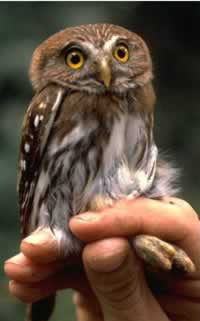 The cactus ferruginous pygmy-owl, Glaucidium brasilianum cactorum (pictured), is a desert-dwelling owl that is approximately 6 inches tall and weighs less than 3 ounces. Yet, despite its diminutive size, it has been at the center of a battle between environmentalists and developers for more than a decade. The owl will be removed from the endangered species list thus freeing up 1.2 million acres in Arizona from critical habitat protection. The Fish and Wildlife Service decided that the bird was not a distinct subspecies and therefore not worthy of protection. This decision is expected to go into effect May 15. "It's anti-science, it's anti-conservation and it's anti-public interest," said Daniel Patterson, a desert ecologist with the Center for Biological Diversity. He claimed the move was a political decision that ignores years of research.
The cactus ferruginous pygmy-owl, Glaucidium brasilianum cactorum (pictured), is a desert-dwelling owl that is approximately 6 inches tall and weighs less than 3 ounces. Yet, despite its diminutive size, it has been at the center of a battle between environmentalists and developers for more than a decade. The owl will be removed from the endangered species list thus freeing up 1.2 million acres in Arizona from critical habitat protection. The Fish and Wildlife Service decided that the bird was not a distinct subspecies and therefore not worthy of protection. This decision is expected to go into effect May 15. "It's anti-science, it's anti-conservation and it's anti-public interest," said Daniel Patterson, a desert ecologist with the Center for Biological Diversity. He claimed the move was a political decision that ignores years of research.
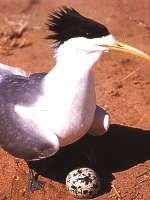 Robben Island, off the coast of Cape Town, is home to about 132 bird species, including the protected African black oystercatcher and about 7,000 breeding pairs of African penguins. Now the rare birds are being killed, and the island's historic museum is fighting the Society for the Prevention of Cruelty to Animals over who is to blame. Among the suspects: feral housecats, giant mice, and, possibly, flesh-eating rabbits -- all introduced by humans. It was noted that after the 1999 cat eradication program, bird colonies -- including swift terns, Sterna bergii (pictured), and Hartlaub's gulls, Larus hartlaubii -- flourished and during the 2001-2002 breeding season, 59 endangered African black oystercatcher chicks reached maturity, according to the Robben Island museum. Les Underhill, head of the University of Cape Town's avian demography unit, who works closely with Robben Island environmental officials, said that last year just three chicks survived, and observers found the telltale signs of strewn-about identification-tag rings and feathers around nests, indicating kills by cats.
Robben Island, off the coast of Cape Town, is home to about 132 bird species, including the protected African black oystercatcher and about 7,000 breeding pairs of African penguins. Now the rare birds are being killed, and the island's historic museum is fighting the Society for the Prevention of Cruelty to Animals over who is to blame. Among the suspects: feral housecats, giant mice, and, possibly, flesh-eating rabbits -- all introduced by humans. It was noted that after the 1999 cat eradication program, bird colonies -- including swift terns, Sterna bergii (pictured), and Hartlaub's gulls, Larus hartlaubii -- flourished and during the 2001-2002 breeding season, 59 endangered African black oystercatcher chicks reached maturity, according to the Robben Island museum. Les Underhill, head of the University of Cape Town's avian demography unit, who works closely with Robben Island environmental officials, said that last year just three chicks survived, and observers found the telltale signs of strewn-about identification-tag rings and feathers around nests, indicating kills by cats.
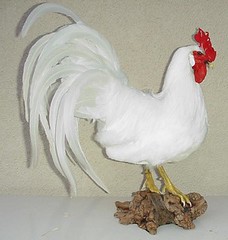 Do you like eating breast meat from chickens? If so, then this story is for you. Apparently, our desire for large breast meat in chickens has led to the selective breeding of roosters that are becoming sociopathic rapists. Because broiler chickens are selectively bred for certain traits, such as breast-meat yield and the skeletal frame to support big breasts, other traits, such as the ability to properly court their hens, is being lost along the way. Suzanne Millman, a professor in the veterinary college at the University of Guelph in Ontario, Canada, says if courtship behavior isn't taken into account when breeding these birds, there is a danger that broiler breeder producers will have to rely on artificial insemination. GrrlScientist wonders: would it even be feasible to raise broiler chickens if artificial insemination becomes essential?
Do you like eating breast meat from chickens? If so, then this story is for you. Apparently, our desire for large breast meat in chickens has led to the selective breeding of roosters that are becoming sociopathic rapists. Because broiler chickens are selectively bred for certain traits, such as breast-meat yield and the skeletal frame to support big breasts, other traits, such as the ability to properly court their hens, is being lost along the way. Suzanne Millman, a professor in the veterinary college at the University of Guelph in Ontario, Canada, says if courtship behavior isn't taken into account when breeding these birds, there is a danger that broiler breeder producers will have to rely on artificial insemination. GrrlScientist wonders: would it even be feasible to raise broiler chickens if artificial insemination becomes essential?
People Helping Birds
A major initiative aimed at saving threatened bird species in Fiji and other Pacific Islands would be launched next year. The project will be funded from sources in England, confirmed BirdLife International's Pacific regional program manager, Don Stewart. He said profits from this year's British Birdfair would be used to launch a regional project aimed at saving threatened parrot species in the Cook Islands, Fiji, French Polynesia and New Caledonia. The theme for this year's fair will be Saving the Pacific's Parrots, with the entire proceeds from the event, expected to be up to 200,000 (F621,214.79) being handed over to fund the Pacific project which will start early in 2007. The main focus will be taking action against invasive alien species, particularly rats because they are known to be responsible for a serious decline in parrot species, especially for the rare Rimatara (Kuhl's) lorikeet, Vini kuhlii.
The Senate has approved a resolution by Senator Dianne Feinstein (D-Ca) declaring 11 May 2006 to be "Endangered Species Day." This special day will provide opportunities for people to learn about the more than 1,000 endangered species that are at risk of extinction in the United States and abroad. Senators Lincoln Chafee (R-R.I.), Mike Crapo (R-Idaho), Hillary Clinton (D-N.Y.), Carl Levin (D-Mich.), Robert C. Byrd (D-W.Va.), Joseph Biden (D-Del.), Maria Cantwell (D-Wash.), Christopher Dodd (D-Conn.), Russ Feingold (D-Wis.), Jack Reed (D-R.I.), Joseph Lieberman (D-Conn.), and Olympia Snowe (R-Maine) cosponsored the resolution. If one of these senate critters belongs to you, be sure to contact him or her to express your appreciation. I am sure they often hear complaints, so make it a point to give them some complimentary feedback!
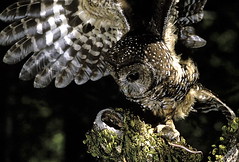 Citing "overwhelming evidence" about the decline of the spotted owl, Strix occidentalis (pictured. Photo; Jeffrey Rich), a bird that became the focal point in the battle between environmentalists and the timber industry in the 1990s, the Seattle Audubon Society launched a legal assault on the Weyerhaeuser Company and the state agency that regulates timber cutting. While the spotted owl was the focus of intense clashes between environmentalists and timber-industry supporters in the early 1990s, those fights centered mostly on national forests. There, logging was severely curtailed to preserve the owl and other species that thrive in older forests. At that time, Weyerhaeuser told the government that it would establish a long-term plan to protect spotted owls on its extensive southwestern Washington holdings, but the plan was never completed. Even though the 1990s plan for saving the owl focused on protecting federal land in national forests, it didn't work: Spotted owls are declining in number in Washington at more than twice the rate predicted by federal biologists.
Citing "overwhelming evidence" about the decline of the spotted owl, Strix occidentalis (pictured. Photo; Jeffrey Rich), a bird that became the focal point in the battle between environmentalists and the timber industry in the 1990s, the Seattle Audubon Society launched a legal assault on the Weyerhaeuser Company and the state agency that regulates timber cutting. While the spotted owl was the focus of intense clashes between environmentalists and timber-industry supporters in the early 1990s, those fights centered mostly on national forests. There, logging was severely curtailed to preserve the owl and other species that thrive in older forests. At that time, Weyerhaeuser told the government that it would establish a long-term plan to protect spotted owls on its extensive southwestern Washington holdings, but the plan was never completed. Even though the 1990s plan for saving the owl focused on protecting federal land in national forests, it didn't work: Spotted owls are declining in number in Washington at more than twice the rate predicted by federal biologists.
Mycoplasma gallisepticum is a bacteria-like disease that causes mycoplasmosis, an infection in birds that can lead to blindness. Historically, mycoplasmosis has been a respiratory disease of domestic poultry and captive raised upland game birds and waterfowl. But until recently, mycoplasmosis was not considered to be infectious to songbirds. However, during the winter of 1993-94, house finches, Carpodacus mexicanus, with severe conjunctivitis infections were first observed in the states of Virginia and Maryland, and they were shown to be suffering from mycoplasmosis. Worse, this disease has apparently infected birds across the ocuntry now because it has been detected for the first time in wild finches in California, according to the state Department of Fish and Game. Because the disease is spread when birds rub their heads on branches and feeders, biologists suggest that people wash their bird feeders with a 10 percent solution of household bleach in water each week, clean up old food around feeders, spread seeds over a large area in the sun rather than use feeders, and replace wooden feeders with plastic or metal feeders, which are easier to clean. Learn more about mycoplasmosis.
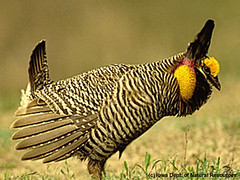 The restoration of prairie land has hatched a welcome spectacle for bird-watchers -- the return of the greater prairie-chicken, Tympanuchus cupido (pictured). Greater prairie-chickens were once the top game bird in Iowa, which at the time was covered in tall prairie and oak savannah, nearly all of which gave way to farming. Overhunting and depletion of habitat around the state caused the disappearance of this dark-feathered bird with the bright orange cap. The birds can be seen near Kellerton, part of the 70,000-acre Grand River Grasslands, an area targeted for prairie restoration that spans into northern Missouri.
The restoration of prairie land has hatched a welcome spectacle for bird-watchers -- the return of the greater prairie-chicken, Tympanuchus cupido (pictured). Greater prairie-chickens were once the top game bird in Iowa, which at the time was covered in tall prairie and oak savannah, nearly all of which gave way to farming. Overhunting and depletion of habitat around the state caused the disappearance of this dark-feathered bird with the bright orange cap. The birds can be seen near Kellerton, part of the 70,000-acre Grand River Grasslands, an area targeted for prairie restoration that spans into northern Missouri.
Would you like to help researchers around the world while watching birds? My Yard Counts is a new citizen-science project that collects information about birds that are found around residences in rural, suburban, and urban settings. Using these data, researchers are hoping to identify the features in yards that are most important to birds. Participants spend 20 minutes watching birds near their homes once a week between April and August. Data is collected through the online eBird program.
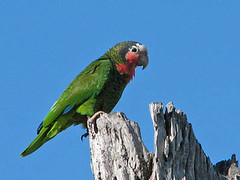 Conservation organizations throughout the Caribbean launched their fifth annual month-long celebration of the region's unique bird life this past weekend. The Caribbean Endemic Bird Festival is one month long, running from Earth Day (April 22nd) through International Biodiversity Day (May 22nd). This celebration is coordinated by the Society for the Conservation and Study of Caribbean Birds (SCSCB), which works closely with BirdLife's Caribbean Program. Activities range from exhibitions of drawings and paintings by local school children, public lectures, photographic exhibitions, church services, bird-watching excursions, and theatrical productions in celebration of the region's rich bird life. (pictured; the near-threatened Cuban parrot, Amazona xantholora).
Conservation organizations throughout the Caribbean launched their fifth annual month-long celebration of the region's unique bird life this past weekend. The Caribbean Endemic Bird Festival is one month long, running from Earth Day (April 22nd) through International Biodiversity Day (May 22nd). This celebration is coordinated by the Society for the Conservation and Study of Caribbean Birds (SCSCB), which works closely with BirdLife's Caribbean Program. Activities range from exhibitions of drawings and paintings by local school children, public lectures, photographic exhibitions, church services, bird-watching excursions, and theatrical productions in celebration of the region's rich bird life. (pictured; the near-threatened Cuban parrot, Amazona xantholora).
Streaming Birds
 This week, the good people of BirdNote tell you about; Monday, American Bittern, Botaurus lentiginosus; Tuesday, snipe hunt; Wednesday, Williamson's Sapsucker, Sphyrapicus thyroideus; Thursday, Frank Bellrose and the Wood Duck, Aix sponsa; and Friday, the Horned Lark, Eremophila alpestris. BirdNotes transport the listener out of the daily grind with two-minute vignettes that incorporate the rich sounds of birds provided by Cornell University and by other sound recordists, with photographs and written stories that illustrate the interesting -- and in some cases, truly amazing -- abilities of birds. Some of the shows are Pacific Northwest-oriented, but many are of general interest. BirdNote can be heard live, Monday through Friday, 8:58-9:00AM in Western Washington state and Southern British Columbia, Canada, on KPLU radio and now also in North Central Washington state on KOHO radio. All episodes are available in the BirdNote archives, both in written transcript and mp3 formats, along with photographs. Listener ideas and comments are welcomed. [rss mp3/podcast].
This week, the good people of BirdNote tell you about; Monday, American Bittern, Botaurus lentiginosus; Tuesday, snipe hunt; Wednesday, Williamson's Sapsucker, Sphyrapicus thyroideus; Thursday, Frank Bellrose and the Wood Duck, Aix sponsa; and Friday, the Horned Lark, Eremophila alpestris. BirdNotes transport the listener out of the daily grind with two-minute vignettes that incorporate the rich sounds of birds provided by Cornell University and by other sound recordists, with photographs and written stories that illustrate the interesting -- and in some cases, truly amazing -- abilities of birds. Some of the shows are Pacific Northwest-oriented, but many are of general interest. BirdNote can be heard live, Monday through Friday, 8:58-9:00AM in Western Washington state and Southern British Columbia, Canada, on KPLU radio and now also in North Central Washington state on KOHO radio. All episodes are available in the BirdNote archives, both in written transcript and mp3 formats, along with photographs. Listener ideas and comments are welcomed. [rss mp3/podcast].
Scientists recently discovered a freshly laid bald eagle egg on an island off the southern California coast. If a chick hatches a few weeks from now, it would be the first successful bald eagle nesting on the northern Channel Islands in more than 50 years. Renee Montagne from National Public Radio's Morning Edition talks with David Garcelon, president of the Institute for Wildlife Studies, a group working to repopulate bald eagles on the islands, about the challenges facing the endangered birds. This link includes a print story, streaming interview [3:30, RealPlayer] and photographs.
Fewer and fewer seabirds are migrating from California to Canada. Scientists are worried that this mysterious disappearance of birds may point to a larger problem. Deirdre Kennedy from National Public Radio's Morning Edition reports from Seattle [3:23, RealPlayer].
BirdCams and Photoessays
The naturalists who write and photograph each issue of This week at Hilton Pond have been busy getting ready for the John Bachman Symposium at Newberry College however, they managed two squeeze in an hour this week to photograph some Eastern Pondhawks over Hilton Pond. These common dragonflies are a delight to watch, although they're not always easy to photograph -- especially in late afternoon. You can view this most recent photoessay at This Week at Hilton Pond as well as a tally of birds banded and recaptured, plus miscellaneous nature notes.
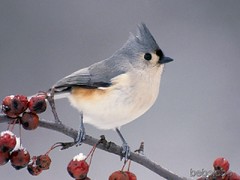 You will love this site! Not only does it show you how to set up your own bird nest cam, but this interesting website is full of video clips of a nesting pair of tufted titmice, Baeolophus bicolor (pictured), and includes a videoblog. Just the other day, I was watching momma titmouse build her nest. Click on the pictures to see the videos. Watching these little birds go about their daily lives will fascinate you, guaranteed.
You will love this site! Not only does it show you how to set up your own bird nest cam, but this interesting website is full of video clips of a nesting pair of tufted titmice, Baeolophus bicolor (pictured), and includes a videoblog. Just the other day, I was watching momma titmouse build her nest. Click on the pictures to see the videos. Watching these little birds go about their daily lives will fascinate you, guaranteed.
Hoot is a kid's film about burrowing owls, Athene cunicularia (pictured. Photo: Jack Nordeen), that is being released in two weeks on 5 May. The site has a trailer as well as a bunch of activities, including an online video game, that your kids (and probably you, too) will enjoy.
The Fine Print: Thanks to my bird pals; "justawriter", Janice, John, Sara, Ian, Dawn, Jeremy, Caren, Bill, Ellen and Ron for some of the news story links that you are enjoying here. Thanks to Ian for catching my errors. All images that appear here are either linked from the news stories that they accompany or they are linked to the site where they are found. You can follow these links by clicking on individual images. The featured image at the top appears here by permission.
Previous : : Birds in the News : : Next
tags: Birds in the News, ornithology, birds, avian, newsletter


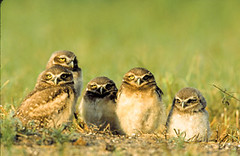
Those "rapist roosters" aren't even close to new -- they were described by Dr. Temple-Grandin in her (wonderful) book (last year?) Animals in Translation, and that was as a past anecdote. See her site at www.grandin.com.
There is so much substance to this issue of BITN that I don't know where to begin commenting. Also I am taking a quick break from work to make this posting, so I have to be brief. Since owls and cacti are both favorites of mine, I immediately focused on the posting about the cactus ferruginous pygmy-owl. Since species vs. subspecies distinctions are critical in the resolution of the owl's status, I wonder what studies support the subspecies conclusion and whether ribosomal DNA studies were employed.
G/S, look later this week in the mail for some "grant" money in support of BITN. You are a superstar!
Sharing one of my birdathon photos from Saturday, a Brown Creeper. Enjoy!
GrrlScientist wonders would it even be feasible to raise broiler chickens if artificial insemination becomes essential?
works for domestic turkeys!
(ps--suggest closing the italics tag)
So glad to come home to Birds in the News after a (as always) long Monday - especially since my brother was just asking me about the bright yellow birds with grey backs he had in his yard!
Excellent edition as usual. Thanks for all of the hard work! Fascinating that birds could survive the last mass extinction event, but we humans seem to be doing everything we can to make sure they don't survive the next.
Lastly, being a geek and all, I am way into the build your own nest cam. In fact, I was discussing it just this last weekend!
Great Birds in the News edition!!! I learn so much each time I read BITN.
Thanks for all your hard work Grrlscientist! It is appreciated.
Also, I did send a thank you to me senator (Mike Crapo) thanking him and asking him to strengthen the ESA. I also put BirdNote on my Podcast downloader. This was a very productive issue of BITN1
Lovely issue. Thank you for the link to the tufted titmice goodness - we don't have that bird species over here, and they're lovely little birds.